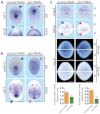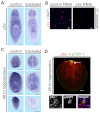pbx is required for pole and eye regeneration in planarians
- PMID: 23318641
- PMCID: PMC3557772
- DOI: 10.1242/dev.083741
pbx is required for pole and eye regeneration in planarians
Abstract
Planarian regeneration involves regionalized gene expression that specifies the body plan. After amputation, planarians are capable of regenerating new anterior and posterior poles, as well as tissues polarized along the anterior-posterior, dorsal-ventral and medial-lateral axes. Wnt and several Hox genes are expressed at the posterior pole, whereas Wnt inhibitory genes, Fgf inhibitory genes, and prep, which encodes a TALE-family homeodomain protein, are expressed at the anterior pole. We found that Smed-pbx (pbx for short), which encodes a second planarian TALE-family homeodomain transcription factor, is required for restored expression of these genes at anterior and posterior poles during regeneration. Moreover, pbx(RNAi) animals gradually lose pole gene expression during homeostasis. By contrast, pbx was not required for initial anterior-posterior polarized responses to wounds, indicating that pbx is required after wound responses for development and maintenance of poles during regeneration and homeostatic tissue turnover. Independently of the requirement for pbx in pole regeneration, pbx is required for eye precursor formation and, consequently, eye regeneration and eye replacement in homeostasis. Together, these data indicate that pbx promotes pole formation of body axes and formation of regenerative progenitors for eyes.
Figures







Similar articles
-
PBX/extradenticle is required to re-establish axial structures and polarity during planarian regeneration.Development. 2013 Feb;140(4):730-9. doi: 10.1242/dev.082982. Epub 2013 Jan 14. Development. 2013. PMID: 23318635 Free PMC article.
-
Stem cell-dependent formation of a functional anterior regeneration pole in planarians requires Zic and Forkhead transcription factors.Dev Biol. 2014 Jun 15;390(2):136-48. doi: 10.1016/j.ydbio.2014.03.016. Epub 2014 Apr 1. Dev Biol. 2014. PMID: 24704339
-
teashirt is required for head-versus-tail regeneration polarity in planarians.Development. 2015 Mar 15;142(6):1062-72. doi: 10.1242/dev.119685. Epub 2015 Feb 27. Development. 2015. PMID: 25725068 Free PMC article.
-
Intercalary regeneration in planarians.Dev Dyn. 2003 Feb;226(2):308-16. doi: 10.1002/dvdy.10249. Dev Dyn. 2003. PMID: 12557208 Review.
-
Stem Cells, Patterning and Regeneration in Planarians: Self-Organization at the Organismal Scale.Methods Mol Biol. 2018;1774:57-172. doi: 10.1007/978-1-4939-7802-1_2. Methods Mol Biol. 2018. PMID: 29916155 Review.
Cited by
-
Wnt, Ptk7, and FGFRL expression gradients control trunk positional identity in planarian regeneration.Elife. 2016 Apr 13;5:e12850. doi: 10.7554/eLife.12850. Elife. 2016. PMID: 27074666 Free PMC article.
-
ChIP-Seq and RNA-Seq analyses identify components of the Wnt and Fgf signaling pathways as Prep1 target genes in mouse embryonic stem cells.PLoS One. 2015 Apr 13;10(4):e0122518. doi: 10.1371/journal.pone.0122518. eCollection 2015. PLoS One. 2015. PMID: 25875616 Free PMC article.
-
The Cellular and Molecular Basis for Planarian Regeneration.Cell. 2018 Oct 4;175(2):327-345. doi: 10.1016/j.cell.2018.09.021. Cell. 2018. PMID: 30290140 Free PMC article. Review.
-
Forkhead containing transcription factor Albino controls tetrapyrrole-based body pigmentation in planarian.Cell Discov. 2016 Aug 2;2:16029. doi: 10.1038/celldisc.2016.29. eCollection 2016. Cell Discov. 2016. PMID: 27551436 Free PMC article.
-
Transcription factor-mediated reprogramming toward hematopoietic stem cells.EMBO J. 2015 Mar 12;34(6):694-709. doi: 10.15252/embj.201490804. Epub 2015 Feb 20. EMBO J. 2015. PMID: 25712209 Free PMC article. Review.
References
-
- Aboobaker A. A. (2011). Planarian stem cells: a simple paradigm for regeneration. Trends Cell Biol. 21, 304-311 - PubMed
-
- Adell T., Salò E., Boutros M., Bartscherer K. (2009). Smed-Evi/Wntless is required for beta-catenin-dependent and -independent processes during planarian regeneration. Development 136, 905-910 - PubMed
-
- Almuedo-Castillo M., Sureda-Gomez M., Adell T. (2012). Wnt signaling in planarians: new answers to old questions. Dev. Biol. 56, 53-65 - PubMed
-
- Arata Y., Kouike H., Zhang Y., Herman M. A., Okano H., Sawa H. (2006). Wnt signaling and a Hox protein cooperatively regulate psa-3/Meis to determine daughter cell fate after asymmetric cell division in C. elegans. Dev. Cell 11, 105-115 - PubMed
Publication types
MeSH terms
Substances
Grants and funding
LinkOut - more resources
Full Text Sources
Other Literature Sources
Miscellaneous

